Abstract
A narrow-band Bragg grating filter based on a long-range surface plasmon polariton (LRSPP) waveguide is theoretically demonstrated. The three-dimensional Au stripe that is embedded in polymer SU-8 acts as both the waveguide and the heating electrode. With the eigen mode expansion and finite element method optimizations, the proposed filter shows a reflectivity of 0.578 and a 3 dB bandwidth of 1.1 nm. The central wavelength can be tuned from 1549.9 nm to 1544.3 nm by varying temperature from 25 °C to 75 °C, while maintaining the optical return loss at −2.5 dB. This proposed tunable filter has potential in on-chip light signal processing.
1. Introduction
Photonic integrated circuits (PICs) have attracted much attention due to the merit of integrating different passive and active optical components of lasers, switches, modulators, and photodiodes on one common platform [1,2,3,4]. As a key device, optical filters have been implemented on different PIC platforms of silicon [5], silicon nitride [6,7], silica [8], InP [9], and polymers [10]. Because of the simple and instant effect, thermal tuning grating filters with a top or buried heater have been reported [6,7,11]. Surface plasmon polariton (SPP) and surface plasmon resonance (SPR) that can offer subwavelength-scale local confinement have been applied in absorbers [12,13,14,15,16,17], sensors [18,19], imaging [20], etc. A long-range surface plasmon polariton (LRSPP) waveguide-based amplifier [21], laser [22,23], sensor [24], and filter [25] have also been reported. In particular, when the metal stripe LRSPP waveguide is embedded in a polymer with low thermal conductivity and high thermo-optic coefficient, favorable tuning performance can be obtained. However, the two-dimensional (2D) geometry with only one-directional periodic variation limits the light reflection, which offers the space for performance improvement by the adoption of three-dimensional (3D) gratings. The combination of 3D LRSPP waveguide gratings and a polymer with a high thermo-optic coefficient is expected to offer better filtering performance.
In this paper, a thermally tunable Bragg grating filter based on an LRSPP waveguide is proposed and theoretically investigated. The gold stripe simultaneously acts as the optical waveguide and the thermal heater. The width and height of the metal grating tooth periodically change along the direction of light propagation. Eigen mode expansion (EME) and the finite element method (FEM) are adopted to study the light reflection and thermal driving behavior, respectively. Due to the construction of 3D configuration, a reflectivity of 0.578 and a 3 dB bandwidth of 1.1 nm can be obtained. When the temperature changes from 25 °C to 75 °C, the peak wavelength in the reflection spectrum shifts from 1549.9 nm to 1544.3 nm. This proposed tunable Bragg grating filter has potential in on-chip signal processing.
2. Design and Optimization
2.1. Bragg Grating
The waveguide Bragg grating filter has a periodic structure. It reflects the incoming light around the Bragg wavelength that is defined as the central wavelength of the grating. The three key performance parameters of the Bragg grating filter are the central wavelength (λ), reflectivity (R), and the bandwidth (∆λ). The central wavelength is determined by the grating period (Λ) and the average effective index (nave).
where m is a positive integer representing the order of grating. To enhance the reflection effect, m is chosen to be 1 in this study. Here, nave can be described as follows [26]:
where is the effective index of Section A, and indicates the effective index of Section B in Figure 1. Furthermore, the bandwidth and reflectivity can be determined as follows
where κ is the coupling coefficient (coupling rate between the forward and backward propagating mode along the periodic structure), L is the length of the Bragg grating, ng is the group index, and R is the reflectivity of the filter [27]. According to Equations (3) and (4), both the bandwidth and the reflectivity depend on the coupling coefficient and Bragg grating length. Therefore, a stronger reflectivity and narrower bandwidth may be obtained by increasing the length of Bragg grating L. However, the accompanied enhancement of coupling coefficient κ will lead to a broadening of the bandwidth, which is unexpected for a narrow-band optical filter. Therefore, compromised gratings can be found by comprehensively investigating the relationship between the filtering performance and geometric parameters.

Figure 1.
Schematic diagram of 3D LRSPP waveguide Bragg grating filter.
2.2. LRSPP Waveguide Grating
The proposed LRSPP waveguide-based Bragg grating filter is shown in Figure 1. The Au stripe widths in Section A and Section B within one period are defined as wA and wB, respectively. Similarly, the heights of Au stripe at Section A and Section B in one period are defined as hA and hB. One complete grating period Λ is the sum of lA and lB. The ultraviolet-sensitive polymer SU-8 (n = 1.570 near 1550 nm at 25 °C) was adopted as the top-cladding and bottom-cladding material. Because of the strong thermal expansion, the density of polymer is reduced when SU-8 is heated, giving SU-8 a negative thermo-optic (TO) coefficient of approximately −1.8 × 10−4/°C [28,29,30,31]. Here, the buried gold stripe not only acts as the LRSPP waveguide grating, but also as a self-driven heater. For the convenience of heating, it would be better to remove the top SU-8 cladding above the Au electrodes. Enough distance between the pad and LRSPP waveguide is desired to eliminate any passive influence on the light propagation around the gratings, as shown in Figure 2. To be noted, although a 3D periodic structure is adopted in this work, the geometric parameters and filtering performance can still be optimized according to Equation (1).
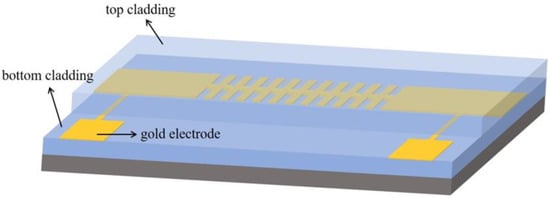
Figure 2.
Reference method of heating buried electrode.
In grating design and optimization, the fill factor f defined by Equation (5) should be considered.
For a fixed grating period Λ, the fill factor will affect neff of the waveguide section. As mentioned in [26], the fill factor impacts both the maximum grating length and the reflectivity peak at the saturation point. Increasing the fill factor implies the length increment of Section B, which would lead to higher loss and a reduction in reflection. Therefore, the loss of the unit cell can be minimized to maximize the reflectance of uniform periodic Bragg gratings. Practically, the minimum feature size should also be considered. After comprehensive consideration, the fill factor was fixed at 50% in this work.
3. Simulations
For filter performance optimization, the fill factor f, grating period Λ, and grating length L can be optimized according to their contribution to the reflection. Therefore, geometric parameters of 3D grating width, height, and period were studied using the EME method.
3.1. Grating Width, Height, and Period
To arrange the central wavelength at 1550 nm, Λ and nave should be confirmed according to Equation (1). For this, a straight LRSPP waveguide with height hAu and width wAu is firstly introduced to study the effective refractive index neff, as shown in the inset of Figure 3. The real part of neff of the straight Au stripe as a function of hAu at different wAu via finite difference eigenmode (FDE) calculations is shown in Figure 3. Since the reflective characteristic of the Bragg grating is utilized in this work, the optical loss induced by absorption of the metal stripe, which mainly relates to the imaginary part of neff, is not discussed here. In addition, to better illustrate the mode profiles for calculating, the cross-sectional views of the mode distribution in the straight LRSPP waveguide with different wAu and hAu are demonstrated in Figure 4. The straight gold stripe symmetrically surrounded by SU-8 offers symmetric mode power distribution. Better mode confinement can be observed when wAu and hAu are increasing. The lowest neff is approximately 1.570 when hAu is 0.025 μm and wAu is 2 μm. According to Equation (1), Λ is 494 nm at 1550 nm. Then, the reflectivity as a function of hAu and wAu was investigated using EME simulations at Λ = 494 nm. Due to the existence of solver differences, to guarantee the central working wavelength at 1550 nm, a bigger neff is more favorable. Therefore, wAu = wB was chosen as 8 μm.
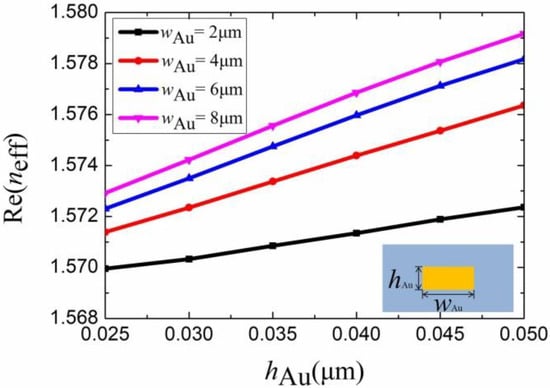
Figure 3.
Real part Re(neff) of the Au stripe as a function hAu at different wAu.
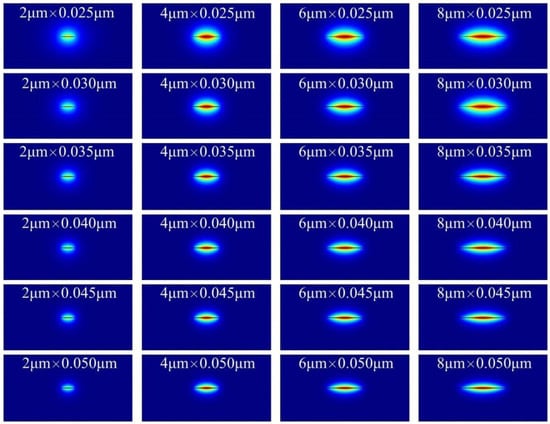
Figure 4.
Cross-sectional views of mode distribution in the straight LRSPP waveguide with different wAu and hAu.
To confirm wA, the reflectivity as a function of wavelength at different wA is shown in Figure 5. Here, hA = hAu = 0.045 μm. C8x means that wB = 8 μm and wA = x μm in one grating period. It can be seen that C82 has the highest reflectivity around 1550 nm.
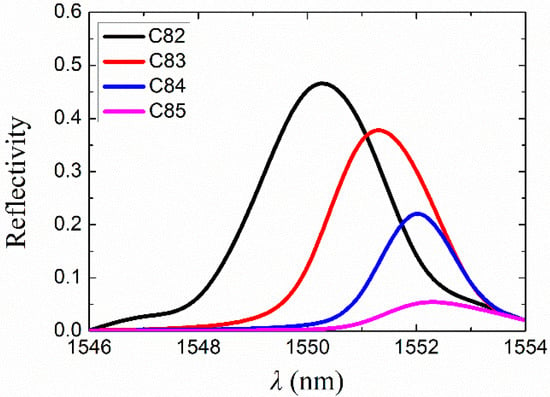
Figure 5.
Reflectivity as a function of wavelength at different wB when hAu is 0.045 μm.
For the C82 grating, hA and hB are optimized within the height range from 0.025 μm to 0.050 μm as shown in Figure 3. However, according to Equations (3) and (4), the objectives of narrow bandwidth and high reflectivity are conflicting and cannot be satisfied simultaneously. There has to be a compromise between the reflectivity and 3 dB bandwidth under different hA and hB combinations. Therefore, hA and hB were set to be 0.045 μm and 0.040 μm, respectively.
3.2. Grating Length
The grating length is defined by the number of the grating period N. According to Equation (4), the length increment of the Bragg grating upon increasing the number of unit cells will enhance the reflectance. Therefore, it is desirable to quantitatively study the relationship between the reflectivity and the grating length, which is defined as
L = Λ × N.
Figure 6 below shows the reflectivity as a function of N. As expected, the reflectivity increased with the increment of grating length L before reaching saturation around 0.575. As shown in Figure 6, when N was 2000, nearly no change in reflectivity could be observed. Considering the lossy issue of metal gratings, N was chosen to be 2000 in the subsequent analysis.
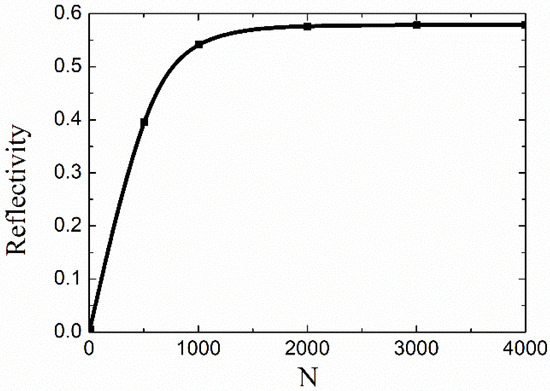
Figure 6.
Reflectivity as a function of the grating period number N.
4. Thermal Analysis
As mentioned above, the unique feature of the LRSPP waveguide device is that it is self-driven, whereby the thermal tuning is directly applied to the metal stripe itself. This can effectively alter the filtering performance. For Bragg gratings with the parameters outlined in Section 3, the thermal and optical characteristics of waveguide materials can be studied to precisely evaluate the influence of heat diffusion on the optical mode propagation. In this work, FEM was used to simulate the thermal steady state of LRSPP waveguide Bragg gratings. The heat transfer conduction can be expressed by
where T denotes the temperature, qs is the density of heat generation, represents the material density, cp is the heat capacity, and k is the thermal conductivity [11]. The following boundary conditions are satisfied:
- (1)
- for the top and lateral surfaces (n = refractive index),
- (2)
- T = T0 for the bottom boundary,
- (3)
- T = Tm for the heater.
The material parameters used in the simulations are listed in Table 1. In the thermal simulation, Si substrate served as a heat sink because of its high heat conductivity. Here, we set T0 = 25 °C to indicate the initial temperature.

Table 1.
Material parameters in simulations.
Figure 7 shows the thermal field distributions when the 8 μm wide and 2 μm wide Au stripes, embedded in 10 μm thick SU-8 claddings, were heated to 75 °C. Since the metal stripe was symmetrically surrounded by low-thermal-conductivity polymer SU-8, an almost symmetric thermal field distribution around the Au stripe can be observed in Figure 7. Compared with the thermal fields in [10], this heating method offers a more uniform thermal field distribution, which is convenient for the analysis of Bragg grating filters.
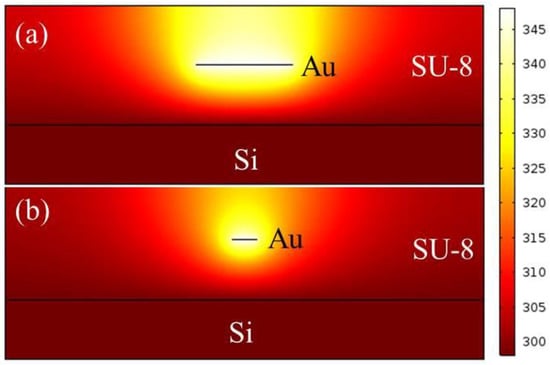
Figure 7.
Temperature distribution of (a) 8 μm wide and (b) 2 μm wide LRSPP waveguide at 75 °C.
To investigate the optical field during heating, the wave equation below was adopted to determine the effective modal index [32].
where Et represents the transverse electric field, and n(x, y) is the refractive index. Due to the almost symmetric refractive index and thermal field distribution, the TM-polarized LRSPP mode along the metal grating showed unremarkable changes at 25 °C and 75 °C. However, a remarkable temperature change would lead to a distinct refractive index change of the SU-8 cladding, which would change the central wavelength of the Bragg grating according to Equation (1). For a 50% fill factor, Equation (2) can be rewritten as follows [33]:
As shown in Figure 8, when Δneff represents the effective index difference between Sections A and B, both nave and Δneff will slightly decrease with the increased temperature due to the high negative thermo-optic coefficient of the polymer cladding.
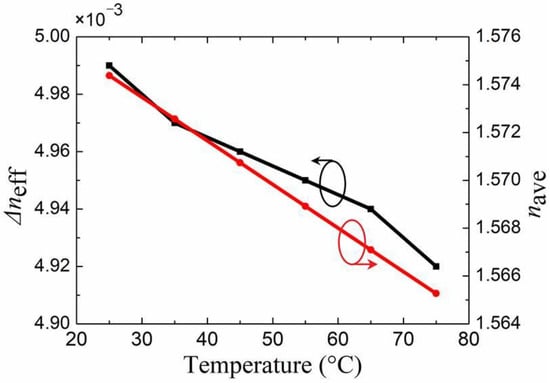
Figure 8.
Average effective index nave and effective index difference Δneff between Sections A and B with temperature variation.
Since the temperature changes lead to the variation of effective index, the confinement factor Γ of Sections A and B at different temperatures can be investigated. Figure 9 shows the confinement factor Γ of Sections A and B for TM mode propagation. The confinement factor of Section A was larger than that of Section B within the temperature range from 25 °C to 75 °C. Both Γ slightly and gradually decreased with the increment in temperature. Waveguides with higher neff and larger Γ are more favorable in terms of compactness. However, polymer and gold have inverse thermo-optic coefficients. The absolute value of the TO coefficient of the polymer is much higher than that of Au. Therefore, the mode power distributed in the SU-8 cladding will be effectively modulated by the thermal field, enabling effective filter tuning [6].
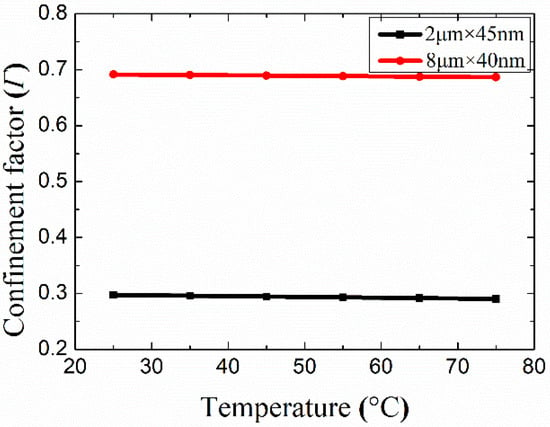
Figure 9.
Confinement factor Γ of Section A and Section B of the LRSPP waveguide grating.
5. Results and Discussion
To investigate the tunability of the grating filter, the optical return losses of the LRSPP waveguide Bragg grating as a function of wavelength at temperatures of 25, 35, 45, 55, 65, and 75 °C were calculated as shown in Figure 10. The central wavelength of the grating filter varied from 1549.9 nm at 25 °C to 1544.3 nm at 75 °C. The optical return loss remained at approximately −2.5 dB as the temperature increased from 25 °C to 75 °C. Furthermore, no remarkable reflection spectrum shape distortion was observed during the heating process. This stable tuning performance mainly stems from the inverse thermo-optic coefficient between polymer SU-8 and metal, which results in limited ng and κ variation. According to Equations (1) and (3), the central wavelength and bandwidth at higher temperature should be consistent with that at 25 °C.
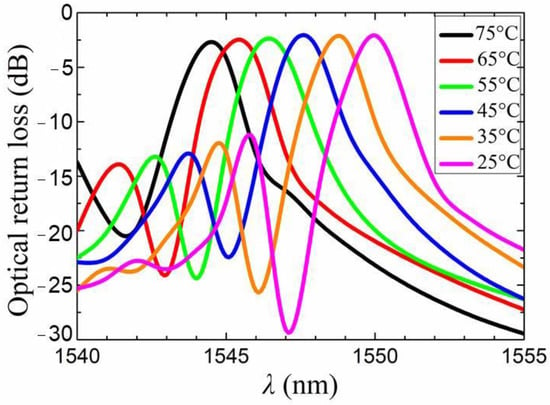
Figure 10.
Optical return loss of gold Bragg grating as a function of wavelength at temperatures of 25, 35, 45, 55, 65, and 75 °C.
To better illustrate the performance improvement, a comparison between 2D and 3D LRSPP waveguide Bragg grating filters was conducted. Here, a 2D LRSPP waveguide Bragg grating implies that the periodical change in waveguide width only happens in the x–z plane. In the y-direction, no waveguide height variation exists in the 2D Bragg grating, which means that Section A and Section B have the same height hA = hB = 0.045 μm. For the 3D waveguide grating, the periodic waveguide width changes in the x–z plane, while the waveguide height also changes in the y-direction, which implies that hA ≠ hB, as shown in Figure 1 In the 3D grating case, Section A and Section B were 2 μm × 0.045 μm and 8 μm × 0.040 μm, respectively. In the 2D grating case, Section A and Section B were 2 μm × 0.045 μm and 8 μm × 0.045 μm, respectively.
Figure 11 shows the reflectivity of the 2D (red line) and 3D (blue line) Bragg grating filters as a function of wavelength at temperature 25 °C. As shown in Figure 11, the 3D grating filter had a larger reflectivity of 0.578 and a narrower 3 dB bandwidth of 1.1 nm. In contrast, the reflectivity and 3 dB bandwidth of the 2D grating filter were just 0.485 and 2.448 nm, respectively.
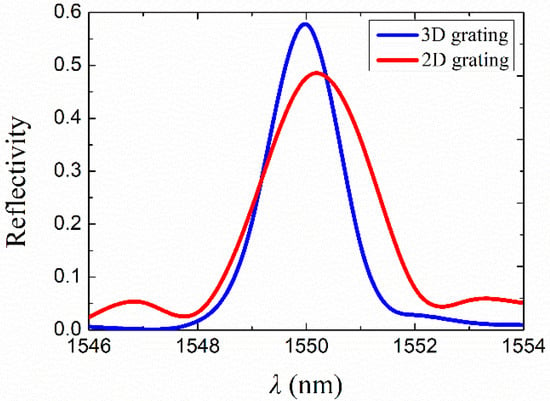
Figure 11.
Reflectivity of 2D (red line) and 3D (blue line) Bragg grating filters as a function of wavelength at temperature 25 °C.
Because of the limitation of lab facilities, only a theoretical design is proposed. According to our previous reported work, a feasible LRSPP waveguide Bragg grating filter fabrication is suggested. Firstly, the SU-8 2005 polymer can be spin-coated on clean Si substrate. After UV irradiation at an exposure dose of 100 mW, the 5 μm thick lower cladding can be formed. Then, photoresists of LOR-1A and S1805 can be sequentially spin-coated on the SU-8 cladding surface and thermally cured. Precise temperature and time control are demanded to guarantee the development. UV exposure can transfer the Section A patterns of the gratings onto the surface of S1805. The undercut configuration then forms through the development in MF321. With another extra low-dose UV exposure, 5 nm deep U-shaped grooves will form on the SU-8 surface due to the further crosslinking of polymer [34]. Then, the 5 nm thick Au film can be deposited by electron beam evaporation at a low rate. Redundant Au can be removed with the liftoff of LOR-1A and S1805 at room temperature. A repeated liftoff process will form the 3D Bragg gratings. Finally, SU-8 upper claddings can be spin-coated and cured.
It should be noted that, as the material with favorable physicochemical properties, SU-8 has been applied in many different waveguide devices, including the construction of the LRSPP waveguide [18,31]. SU-8 has a relatively larger thermo-optic coefficient, which allows low-power operation and favorable mode confinement. Moreover, SU-8 can endure high-temperature treatment and the erosion of different chemical solvents, making it suitable for double-layer liftoff Au stripe fabrication.
Honestly speaking, the 3D version truly poses a greater challenge for fabrication. Aiming at a sharper and narrower band, there indeed exist other approaches, such as increasing the grating length. However, there are intrinsic limitations in the 2D plan. One is the saturation of reflectivity and bandwidth as the grating length is constantly increasing. Another is the sacrifice of compactness, because a smaller footprint is more profitable to construct multifunctional integration. Therefore, although the extra liftoff process complicates the fabrication, the sacrifice of cost and complexity offers effective filtering with compactness. Moreover, making use of SU-8 film thickness shrinking, a phenomenon was observed in our previous study [34], may promise the use of one-step photolithography and Au deposition to form the 3D waveguide grating.
Since elaborate control is demanded in practical fabrication, and the fabrication error is unavoidable, the fabrication error was also studied as shown in Figure 12. Almost no change occurred in the reflectivity spectra when the fill factor was 49%, 50%, and 51%. Hence, the fabrication error of the proposed 3D LRSPP Bragg grating filter was larger than 10 nm.
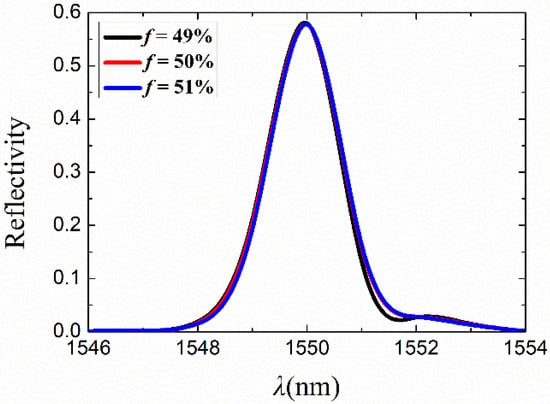
Figure 12.
Impact of fabrication error on the reflection spectrum.
To better evaluate the proposed filter, a quantitative performance comparison between the proposed filter and that of previous reports was conducted. Due to the diversity of principles and device structures, the comparison was performed in term of materials, structure, and bandwidth. As shown in Table 2, compared with the polymer/SiN hybrid waveguide grating filter [6], the proposed 3D LRSPP waveguide Bragg grating filter showed a smaller 3 dB bandwidth (f3-dB). Furthermore, no external electrode was needed for the tuning function. Thanks to the high thermo-optic coefficient of polymer SU-8 adopted in this work, the 3D LRSPP waveguide Bragg grating exhibited a wider bandwidth compared to that in [27], in which the tunable capability was limited. In contrast, a much wider working bandwidth was demonstrated in [35]. However, a smaller f3-dB was observed in this proposed design. Comprehensively speaking, a balanced performance could be obtained with the construction of the 3D LRSPP waveguide Bragg grating. Experimental results were demonstrated in [6,27].

Table 2.
Narrow bandwidth filtering performance comparison.
6. Conclusions
In summary, an LRSPP waveguide Bragg grating filter, which was constructed by embedding the 3D gold stripe in SU-8 cladding, was theoretically proposed. The metal stripe acts as both the waveguide and the heating electrode. Geometric parameters were optimized by eigen mode expansion and the finite element method. The optimized performance showed a reflectivity of 0.578 and 3 dB bandwidth of 1.1 nm. The central wavelength could be tuned from 1549.9 nm to 1544.3 nm by varying the temperature from 25 °C to 75 °C, while maintaining the optical return loss at −2.5 dB. This proposed tunable filter has potential in on-chip light signal processing.
Author Contributions
Conceptualization and resources, D.Z.; formal analysis and investigation, Y.X.; validation, J.Y.; data curation, M.W.; funding acquisition and writing—review and editing, X.S. All authors read and agreed to the published version of the manuscript.
Funding
This study was supported by the National Key Research and Development Program of China (2019YFB2203001).
Data Availability Statement
No applicable.
Conflicts of Interest
The authors declare no conflict of interest.
References
- Kobayashi, N.; Sato, K.; Namiwaka, M.; Yamamoto, K.; Watanabe, S.; Kita, T.; Yamada, H.; Yamazaki, H. Silicon photonic hybrid ring-filter external cavity wavelength tunable lasers. J. Lightwave Technol. 2015, 33, 1241–1246. [Google Scholar] [CrossRef]
- Xu, Y.; Liu, S.; Liu, T.; Gao, Y.; Yin, Y.; Sun, X.; Zhang, D. Optical switch based on Ge2Sb2Se4Te1-assisted racetrack microring. Photonics 2022, 9, 117. [Google Scholar] [CrossRef]
- Chen, W.; Xu, Y.; Gao, Y.; Ji, L.; Wang, X.; Sun, X.; Zhang, D. A broadband polarization-insensitive graphene modulator based on dual built-in orthogonal slots plasmonic waveguide. Appl. Sci. 2021, 11, 1897. [Google Scholar] [CrossRef]
- Wang, Y.; Wang, Z.; Yu, Q.; Xie, X.; Posavitz, T.; Mitos, M.J.; Ramaswamy, A.; Norberg, E.J.; Fish, G.A.; Beling, A. High-power photodiodes with 65 GHz bandwidth heterogeneously integrated onto silicon-on-Insulator nano-waveguides. IEEE J. Sel. Top. Quantum Electron. 2018, 24, 1–6. [Google Scholar] [CrossRef]
- Okayama, H.; Onawa, Y.; Takahashi, H.; Shimura, D.; Yaegashi, H.; Sasaki, H. Polarization insensitive silicon waveguide wavelength filter using polarization rotator and mode conversion Bragg grating with resonator cavity. Jpn. J. Appl. Phys. 2020, 59, 128002. [Google Scholar] [CrossRef]
- Zhang, Z.; Novo, A.M.; Liu, D.; Keil, N.; Grote, N. Compact and tunable silicon nitride Bragg grating filters in polymer. Opt. Commun. 2014, 321, 23–27. [Google Scholar] [CrossRef]
- Zhang, Z.; Liu, D.; Felipe, D.D.; Liu, A.; Keil, N.; Grote, N. Polymer embedded silicon nitride thermally tunable Bragg grating filters. Appl. Phys. Lett. 2013, 102, 181105. [Google Scholar] [CrossRef]
- Jin, L.; Lauro, L.D.; Pasquazi, A.; Peccianti, M.; Moss, D.J.; Morandotti, R.; Little, B.E.; Chu, S.T. Optical multi-stability in a nonlinear high-order microring resonator filter. APL Photon. 2020, 5, 056106. [Google Scholar] [CrossRef]
- Laere, F.V.; Roelkens, G.; Ayre, M.; Schrauwen, J.; Baets, R. Compact and highly efficient grating couplers between optical fiber and nanophotonic waveguides. IEEE J. Light. Technol. 2007, 25, 151–156. [Google Scholar] [CrossRef] [Green Version]
- Liu, A.; Felipe, D.D.; Zawadzki, C.; Keil, N.; Grote, N. Birefringence and reflectivity of all-polymer tunable Bragg grating filters with microheaters. IEEE Phocechnol. Lett. 2018, 30, 1325–1328. [Google Scholar] [CrossRef]
- Liu, A.; Zhang, Z.; Felipe, D.D.; Keil, N.; Grote, N. Power-efficient thermo-optic tunable filters based on polymeric waveguide Bragg gratings. IEEE Photon. Technol. Lett. 2014, 26, 313–315. [Google Scholar] [CrossRef]
- Zheng, Z.; Luo, Y.; Yang, H.; Yi, Z.; Zhang, J.; Song, Q.; Yang, W.; Liu, C.; Wu, X.; Wu, P. Thermal tuning of terahertz metamaterial properties based on phase change material vanadium dioxide. Phys. Chem. Chem. Phys. 2022, 24, 8846–8853. [Google Scholar] [CrossRef] [PubMed]
- Chen, H.; Chen, Z.; Yang, H.; Wen, L.; Yi, Z.; Zhou, Z.; Dai, B.; Zhang, J.; Wu, X.; Wu, P. Multi-mode surface plasmon resonance absorber based on dart-type single-layer graphene. RSC Adv. 2022, 12, 7821–7829. [Google Scholar] [CrossRef] [PubMed]
- Zhao, F.; Lin, J.; Lei, Z.; Yi, Z.; Qin, F.; Zhang, J.; Liu, L.; Wu, X.; Yang, W.; Wu, P. Realization of 18.97% theoretical efficiency of 0.9 µm thick c-Si/ZnO heterojunction ultrathin-film solar cells via surface plasmon resonance enhancement. Phys. Chem. Chem. Phys. 2022, 24, 4871–4880. [Google Scholar] [CrossRef] [PubMed]
- Zheng, Z.; Zheng, Y.; Luo, Y.; Yi, Z.; Zhang, J.; Liu, Z.; Yang, W.; Yu, Y.; Wu, X.; Wu, P. Switchable terahertz device combining ultra-wideband absorption and ultra-wideband complete reflection. Phys. Chem. Chem. Phys. 2022, 24, 2527–2533. [Google Scholar] [CrossRef]
- Wu, X.; Zheng, Y.; Luo, Y.; Zhang, J.; Yi, Z.; Wu, X.; Cheng, S.; Yang, W.; Yu, Y.; Wu, P. A four-band and polarization-independent BDS-based tunable absorber with high refractive index sensitivity. Phys. Chem. Chem. Phys. 2021, 23, 26864–26873. [Google Scholar] [CrossRef]
- Zhou, F.; Qin, F.; Yi, Z.; Yao, W.T.; Liu, Z.; Wu, X.; Wu, P. Ultra-wideband and wide-angle perfect solar energy absorber based on Ti nanorings surface plasmon resonance. Phys. Chem. Chem. Phys. 2021, 23, 17041–17048. [Google Scholar] [CrossRef]
- Ji, L.; Sun, X.; He, G.; Liu, Y.; Wang, X.; Yi, Y.; Chen, C.; Wang, F.; Zhang, D. Surface plasmon resonance refractive Index sensor based on ultraviolet bleached polymer waveguide. Sens. Actuator B-Chem. 2017, 244, 373–379. [Google Scholar] [CrossRef]
- Ji, L.; Yang, S.; Shi, R.; Fu, Y.; Su, J.; Wu, C. Polymer waveguide coupled surface plasmon refractive index sensor: A theoretical study. Photonic Sens. 2020, 10, 353–363. [Google Scholar] [CrossRef]
- Lertvachirapaiboon, C.; Baba, A.; Ekgasit, S.; Shinbo, K.; Kato, K.; Kaneko, F. Transmission surface plasmon resonance imaging of silver nanoprisms enhanced propagating surface plasmon resonance on a metallic grating structure. Sens. Actuator B-Chem. 2017, 249, 39–43. [Google Scholar] [CrossRef]
- Leon, I.D.; Berini, P. Spontaneous emission in long-range surface plasmon-polariton amplifiers. Phys. Rev. B. 2011, 83, 081414. [Google Scholar] [CrossRef]
- Marell, M.J.H.; Smalbrugge, B.; Geluk, E.J. Plasmonic distributed feedback lasers at telecommunications wavelengths. Opt. Express. 2011, 19, 15109–15118. [Google Scholar] [CrossRef] [PubMed] [Green Version]
- Ding, K.; Liu, Z.; Yin, L. Electrical injection, continuous wave operation of subwavelength-metallic-cavity lasers at 260 K. Appl. Phys. Lett. 2011, 98, 231108. [Google Scholar] [CrossRef] [Green Version]
- Xu, Y.; Wang, F.; Gao, Y.; Zhang, D.; Sun, X.; Berini, P. Straight long-range surface plasmon polariton waveguide sensor operating at λ0 = 850 nm. Sensors 2020, 20, 2507. [Google Scholar] [CrossRef] [PubMed]
- Lee, J.; Lu, F.; Belkin, M.A. Widely-tunable optical bandpass filter based on long-range surface plasmon polaritons. Proc. SPIE. 2012, 8457, 84572G. [Google Scholar]
- Charbonneau, S.J.; Berini, P. Theoretical performance of Bragg gratings based on long-range surface plasmon-polariton waveguides. J. Opt. Soc. Am. A Opt. Image Sci. Vis. 2006, 23, 1757–1767. [Google Scholar] [CrossRef] [PubMed]
- Dorian, O.; Diego, P.G.; Carlos, A.R. Subwavelength engineering and asymmetry: Two efficient tools for sub-nanometer-bandwidth silicon Bragg filters. Opt. Lett. 2018, 43, 3208–3211. [Google Scholar]
- Diemeer, M. Polymeric thermo-optic space switches for optical communications. Opt. Mater. 1998, 9, 192–200. [Google Scholar] [CrossRef]
- Huang, S.T.; Lai, C.C.; Sheu, F.W.; Tsai, W.S. Characterization of long-range plasmonic waveguides at visible to near-infrared regime. AIP Adv. 2017, 7, 125221. [Google Scholar] [CrossRef]
- Vernoux, C.; Chen, Y.T.; Markey, L.; Sparchez, C.; Aarocas, J.; Felder, T.; Neitz, M.; Brusberg, L.; Weeber, J.C.; Bozhevolnyi, S.I.; et al. Flexible long-range surface plasmon polariton single-mode waveguide for optical interconnects. Opt. Mater. Express 2018, 8, 469–484. [Google Scholar] [CrossRef]
- Ji, L.; He, G.; Gao, Y.; Sun, X.; Yi, Y.; Wang, X.; Chen, C.; Wang, F.; Zhang, D. SU-8 grating assisted intermodal interference in surface plasmon polariton waveguide. Opt. Mater. Express 2017, 7, 2560–2570. [Google Scholar] [CrossRef]
- Liu, A.; Zhang, Z.; Liu, D.; Keil, N.; Grote, N. Thermo-optic simulations of silicon nitride/polymer hybrid waveguides. Integr. Opt. Phys. Simul. Int. Soc. Opt. Photonics 2013, 8781, 878105. [Google Scholar]
- Gazzaz, K.; Berini, P. Theoretical biosensing performance of surface plasmon polariton Bragg gratings. Appl. Opt. 2015, 54, 1673–1680. [Google Scholar] [CrossRef]
- Ji, L.; Liu, T.; He, G.; Sun, X.; Wang, X.; Yi, Y.; Chen, C.; Wang, F.; Zhang, D. UV-written long-period grating based on long-range surface plasmon-polariton waveguide. IEEE Photon. Technol. Lett. 2016, 28, 633–636. [Google Scholar] [CrossRef]
- Feng, H.; Liu, Z.; Zhang, J.; Ran, L.; Gao, Y. An ultra-high efficient plasmon waveguide filter with enhanced filtering effect. Opt. Commun. 2021, 499, 127287. [Google Scholar] [CrossRef]
Publisher’s Note: MDPI stays neutral with regard to jurisdictional claims in published maps and institutional affiliations. |
© 2022 by the authors. Licensee MDPI, Basel, Switzerland. This article is an open access article distributed under the terms and conditions of the Creative Commons Attribution (CC BY) license (https://creativecommons.org/licenses/by/4.0/).